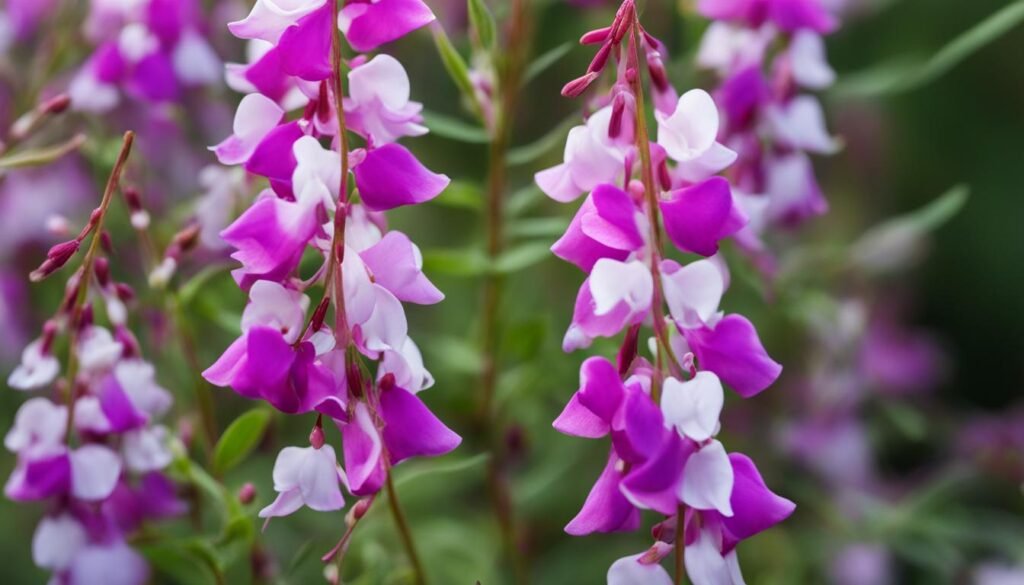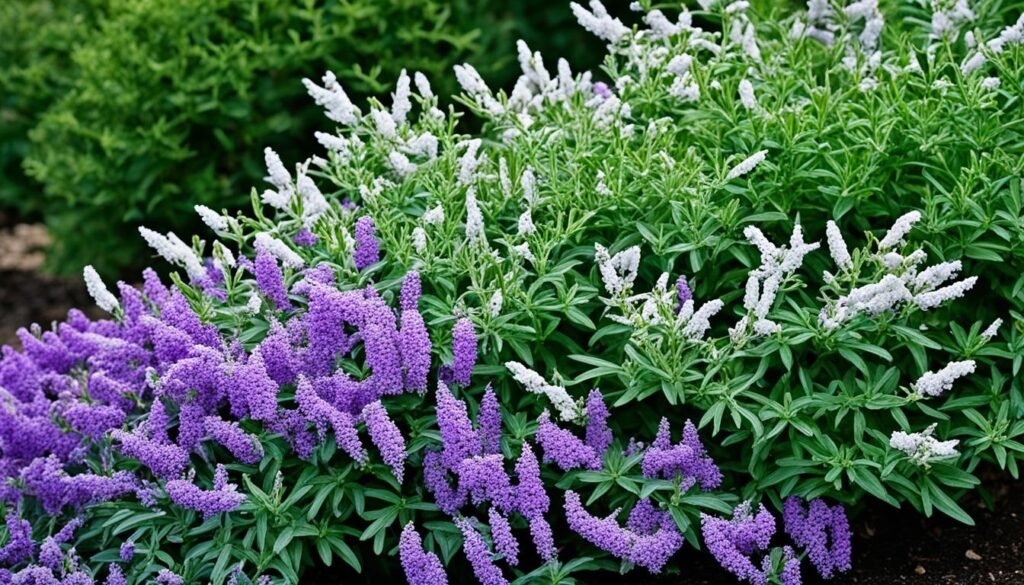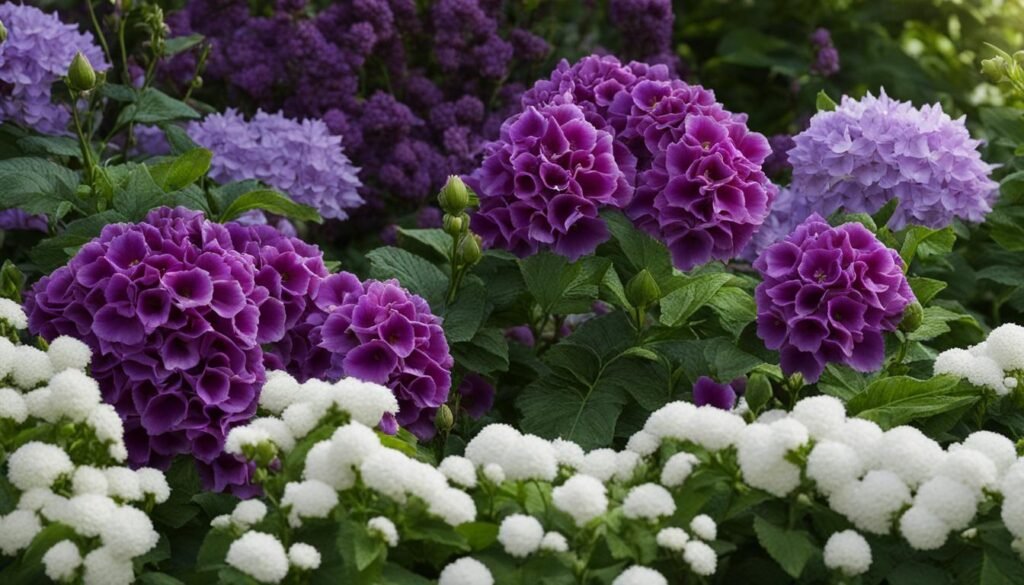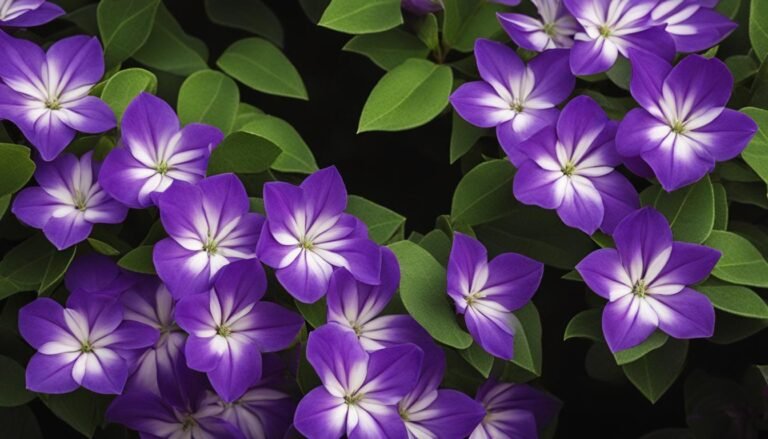Imagine walking through a peaceful garden, mesmerized by the delicate beauty of nature. As I strolled through a botanical garden one sunny afternoon, I stumbled upon a breathtaking sight – bushes with stunning purple and white blooms. The vibrant colors filled the air with an intoxicating scent and added an aura of elegance to the surroundings.
I paused for a moment, captivated by the harmonious contrast of the purple and white flowers. The purple petals exuded a sense of regality, while the white blossoms brought a sense of purity and serenity. It was as if nature had its own palette, carefully selecting these colors to create a masterpiece.
I couldn’t help but marvel at the diverse range of shapes and sizes these flowering shrubs exhibited. Each bush had its unique personality, from trumpet-shaped flowers to cascading pea-like blossoms. It was a visual feast for the senses, and I found myself drawn to the enchanting allure of these garden plants.
As I continued my exploration, I couldn’t help but appreciate the effort that goes into cultivating and maintaining these magnificent bushes. From the acidic soil required by azaleas to the full sun exposure preferred by the Blue Mist Spiraea, each variety had its specific needs. Yet, the reward of witnessing their vibrant display was undoubtedly worth the care and attention.
If you’re looking to transform your own garden into a canvas of purple and white, fear not. In this article, we’ll explore a variety of flowering shrubs with purple and white blooms, their unique characteristics, and the best tips for their cultivation. So, let’s dive in and discover the wonders that these stunning bushes have to offer.
Key Takeaways:
- There are various bushes with purple and white blooms that can add a touch of royalty and elegance to your garden.
- These flowering shrubs come in different shapes, sizes, and colors, providing a diverse range of options to suit any garden aesthetic.
- Each bush has its specific needs in terms of sunlight and soil conditions, so it’s essential to understand their requirements for optimal growth.
- Creating a vibrant landscape with these colorful flowering bushes can transform your garden into a captivating sanctuary.
- Stay tuned as we explore the specific varieties of bushes with purple and white blooms and provide valuable tips on their cultivation.
Azaleas – Beautiful Trumpet-Shaped Flowers
Azaleas are stunning flowering shrubs that are beloved for their exquisite trumpet-shaped flowers. These vibrant blossoms come in a variety of shades, including purple, white, pink, red, and yellow, adding a splash of color to any garden. Azaleas offer a breathtaking display with their delicate petals and elegant form.
There are two main types of azaleas: evergreen and deciduous shrubs. Evergreen azaleas maintain their foliage year-round, providing a lush backdrop even during the winter months. On the other hand, deciduous azaleas shed their leaves in the fall, showcasing their beautiful blooms against a bare backdrop.
To cultivate healthy and thriving azaleas, it is important to consider their specific soil requirements. These shade-loving shrubs prefer acidic nutrient-rich soil that is well-draining. The acidic soil pH enables them to absorb essential nutrients effectively and promotes optimum growth and blossom development.
Azaleas thrive in partial shade to full shade conditions, making them an excellent choice for gardens with limited sunlight. Their ability to flourish in shaded areas allows for versatile landscaping options and provides an opportunity to introduce vibrant color to spaces that may lack direct sunlight.
Purple and White Flowering Azaleas
One of the most sought-after color varieties of azaleas is the purple and white flowering types. These azaleas mesmerize with their contrasting hues, creating an eye-catching visual impact.
| Purple Flowering Azaleas | White Flowering Azaleas |
|---|---|
| Mary Poppins | Snow |
| Autumn Sangria | Hershey’s Red |
| Orchid Lights | Polar Ice |
The purple flowering azaleas, such as Mary Poppins, Autumn Sangria, and Orchid Lights, enchant with their rich and velvety purple petals. These varieties infuse the garden with a regal air and create a captivating focal point.
In contrast, white flowering azaleas, like Snow, Hershey’s Red, and Polar Ice, bring a sense of purity and elegance. The pristine white blooms evoke a serene atmosphere and offer a striking contrast against the lush green foliage.
Some may believe that azaleas are finicky plants that require meticulous care. However, with proper consideration of their specific needs, azaleas can thrive and reward gardeners with breathtaking displays of color year after year.
Blue Mist Spiraea – Fragrant Clusters of Misty Petals
When it comes to adding vibrant colors and delightful fragrances to your garden, the Blue Mist Spiraea is an excellent choice. This deciduous shrub is known for its mesmerizing blue and blue-purple flowers that resemble delicate misty petals. Not only does it offer a visual treat, but it also releases a delightful fragrance that engulfs your senses.
Growing well in full sun, the Blue Mist Spiraea thrives in bright and sunny locations. It is a low-mound shrub that adds a beautiful touch to any landscape design. The Blue Mist Spiraea comes in various foliage colors, ranging from silver-green to darker green, and even silver with brighter yellow-green foliage. This diversity in foliage colors adds depth and visual interest to your garden.
One of the remarkable features of the Blue Mist Spiraea is its extended blooming period. It bursts into bloom during the summer months, allowing you to enjoy its delicate flowers for an extended period. With its papery petals and alluring shades of blue and purple, it creates a captivating display in your garden.

“The Blue Mist Spiraea, with its fragrant clusters of misty petals, is a stunning addition to any garden. Its vibrant blue and blue-purple flowers bring a touch of enchantment and charm to your outdoor space.”
Butterfly Bush – Spiky Clusters of Delicate Flowers
The Butterfly Bush is a stunning deciduous shrub that is cherished for its long, bright green leaves and mesmerizing clusters of spiky flowers. With its vibrant shades of purple, white, red, yellow, and pink, it adds a pop of color and beauty to any garden or landscape.
This pollinator-friendly shrub is adored by butterflies and bees, making it a fantastic addition to any garden space that aims to attract and support local wildlife. The Butterfly Bush blooms throughout the summer and fall, providing a steady supply of vibrant blossoms for these important pollinators.
To thrive and show off its full potential, the Butterfly Bush requires full sun exposure. It thrives in well-drained, loamy sandy soil, which provides the ideal growing conditions for this deciduous shrub. Additionally, this shrub is hardy and can tolerate moderate drought conditions, making it a resilient and low-maintenance choice for garden enthusiasts.
Key Characteristics of the Butterfly Bush:
- Deciduous shrub with long bright green leaves
- Clusters of spiky flowers in vibrant shades of purple, white, red, yellow, and pink
- Pollinator-friendly, loved by butterflies and bees
- Thrives in full sun
- Requires well-drained, loamy sandy soil
- Hardy and low-maintenance
With its spiky clusters of delicate flowers, the Butterfly Bush adds a touch of elegance and allure to any garden or landscape. Its attractive foliage and pollinator-friendly nature make it a perfect choice for those looking to create a vibrant and environmentally-friendly outdoor space.
| Plant Name | Scientific Name | Bloom Colors | Sun Exposure | Soil Type |
|---|---|---|---|---|
| Butterfly Bush | Buddleja davidii | Purple, White, Red, Yellow, Pink | Full Sun | Loamy Sandy |
Bush Clover – Cascading Pea-Shaped Flowers
Bush Clover is a beautiful pink-purple flowering shrub that adds a pop of color to any garden. With its cascading pea-shaped flowers, this heat-loving shrub creates a stunning visual display. The vibrant blooms attract butterflies and other pollinators, making it a delightful addition to your landscape.
This shrub thrives in warmer climates and loves the heat, making it a great choice for gardeners in sunny regions. It is drought-resistant, meaning it can flourish even in dry conditions. Its ability to adapt to different weather conditions makes it a low-maintenance option for busy gardeners.
To ensure the health and longevity of your Bush Clover, it’s important to plant it in well-draining soil. This allows excess water to drain away, preventing root rot and other issues. Additionally, once Bush Clover is established, it becomes even more drought-resistant, reducing the need for frequent watering.

Pruning is an essential part of caring for Bush Clover. By pruning in late winter and spring, you can encourage new growth and stimulate more blooms. It’s recommended to remove dead or damaged branches, as well as any overgrowth that may hinder the plant’s overall appearance.
With its vibrant pink-purple flowers and tolerance for heat and drought, Bush Clover is an excellent choice for gardeners seeking a colorful and resilient shrub for their landscape.
Chaste Tree – Flowering Sage-Like Shrubs
When it comes to cool purple flowering shrubs, the Chaste Tree is a stunning addition to any garden. With its vibrant purple flowers that resemble flowering sage, this temperate zone plant adds a touch of elegance and charm to your outdoor space. It can also be grown as a flowering tree in certain regions, adding height and structure to your landscape.
One of the advantages of the Chaste Tree is its low-maintenance nature. This shrub requires minimal care and attention while still providing a beautiful display of colorful blooms. Its balanced growth ensures a well-proportioned and healthy plant.
The Chaste Tree is known for attracting pollinators with its showy flower heads. Bees, butterflies, and other beneficial insects are drawn to the nectar-rich blossoms, creating a vibrant and buzzing ecosystem within your garden. This makes the Chaste Tree not only visually appealing but also beneficial for the environment.

This shrub is highly adaptable and drought-resistant, making it ideal for various climates. It is not picky about soil type as long as it’s loose and well-drained. Whether you have sandy or clay soil, the Chaste Tree can thrive and add a splash of color to your garden.
With its beautiful purple flowers, low-maintenance nature, and ability to attract pollinators, the Chaste Tree is a wonderful choice for gardeners looking to add a touch of cool purple to their landscape. Its balanced growth and adaptability make it an excellent shrub for both experienced and novice gardeners alike.
Clematis – Perennial Climbing Vine or Shrub
When it comes to adding a touch of elegance and charm to your garden, clematis is an excellent choice. This versatile plant can be grown as both a climbing vine or a shrub, allowing for endless possibilities in your garden design. With its stunning purple flowering shrub varieties, clematis is sure to catch the eye and become a focal point in any outdoor space.
Clematis comes in many different shades of purple, ranging from deep royal purple to soft lavender. These beautiful blooms can add a pop of color and vibrancy to any garden. But what truly sets clematis apart is the variety of bloom shapes it offers. From bell-shaped to star-shaped flowers, each blossom is unique and captivating.
To maximize the growth and beauty of your clematis, consider planting it near a trellis or using a trellis plant support system. This will encourage the vine to climb and create a stunning vertical display. Alternatively, hanging pots can also be used to accentuate the cascading growth habit of certain clematis varieties.
Popular Clematis Variety: Betty Corning
One popular clematis variety that is often grown as a shrub is ‘Betty Corning’. This cultivar features beautiful bell-shaped blooms in shades of pale lavender and light purple. Its delicate and charming flowers make it a favorite among gardeners looking for a low-maintenance, yet stunning purple flowering shrub.
Whether you choose to grow clematis as a climbing vine or a shrub, this plant will surely become a standout feature in your garden. With its purple hues, bell-shaped and star-shaped blooms, and versatile growth habit, clematis is the perfect choice for any gardener looking to add a touch of beauty and elegance to their outdoor space.

Stay tuned for the next section where we’ll explore another stunning flowering shrub that will add beauty and charm to your garden.
Daphne Marianni – Fragrant Cluster of Velveteen-Looking Flowers
If you’re looking for a stunning shrub that not only adds beauty to your garden but also fills the air with a delightful fragrance, look no further than Daphne Marianni. This versatile shrub can be either evergreen or deciduous, making it suitable for a range of climates and gardening preferences.
Daphne Marianni is known for its attractive foliage, with long, glossy leaves that provide a lush and vibrant backdrop to its delicate blooms. Speaking of blooms, this shrub is a late winter bloomer, adding a touch of color and cheer to your garden when most other plants are still in their dormant phase.
The flowers of Daphne Marianni are truly a sight to behold. They form in clusters, with fragrant white petals that are tinged with pale purple or pink. The velvety texture of the petals lends an elegant and luxurious feel to these blossoms, making them a standout feature of this shrub.
One of the remarkable qualities of Daphne Marianni is its fragrance. The blooms emit a captivating scent that fills the air with sweetness, attracting pollinators such as butterflies and bees. This not only adds to the charm of your garden but also supports the ecosystem by providing a food source for these essential creatures.
In terms of care, Daphne Marianni is a hardy shrub that can thrive in cooler climates. It requires minimal pruning, making it a low-maintenance option for gardeners. However, it’s important to ensure that the soil is well-drained to prevent waterlogged roots, which can be detrimental to the plant’s health.
To encourage optimal growth and blooms, it’s best to plant Daphne Marianni in an area that receives ample sunlight. This shrub is also adaptable to different soil types, as long as they provide good drainage. With proper care and the right conditions, Daphne Marianni will reward you with its enchanting presence year after year.
To give you a clearer picture of Daphne Marianni’s characteristics, here’s a handy summary:
| Characteristics | Description |
|---|---|
| Type | Evergreen or deciduous shrub |
| Foliage | Long glossy leaves |
| Bloom Time | Late winter |
| Flower Color | Fragrant white flowers tinged with pale purple or pink |
| Fragrance | Delightful and captivating scent |
| Care | Hardy in cooler climates, minimal pruning required, well-drained soil, and ample sunlight |
With its fragrant cluster of velveteen-looking flowers, Daphne Marianni is a true gem in the world of flowering shrubs. Its attractive foliage, late winter blooming, and captivating fragrance make it a must-have for any garden. Whether you choose the evergreen or deciduous variety, this shrub will bring beauty and joy to your outdoor space.

Conclusion
By incorporating colorful flowering bushes into your garden, you can create a visually stunning and vibrant landscape. These landscaping shrubs with dual-colored blooms, particularly those with purple and white flowers, add an element of elegance and charm to any outdoor space. Whether you choose azaleas, butterfly bushes, or clematis, each plant offers its own unique beauty and requires careful consideration of sunlight and soil conditions for optimal growth.
Imagine the breathtaking sight of purple and white flowers blooming harmoniously together, attracting pollinators and creating a delightful sensory experience in your garden. These plants not only provide aesthetic appeal but also contribute to a balanced ecosystem, benefiting both you and the environment.
With the careful selection of plants with purple and white blooms, you can transform your garden into a vibrant paradise. Plant them in strategic locations to create focal points and create a harmonious color palette. The combination of these colorful flowering bushes will add depth and texture to your landscape, creating a truly enchanting outdoor space. Embrace the beauty of nature by incorporating these stunning plants into your gardening repertoire and enjoy an abundance of colorful blooms year after year.
